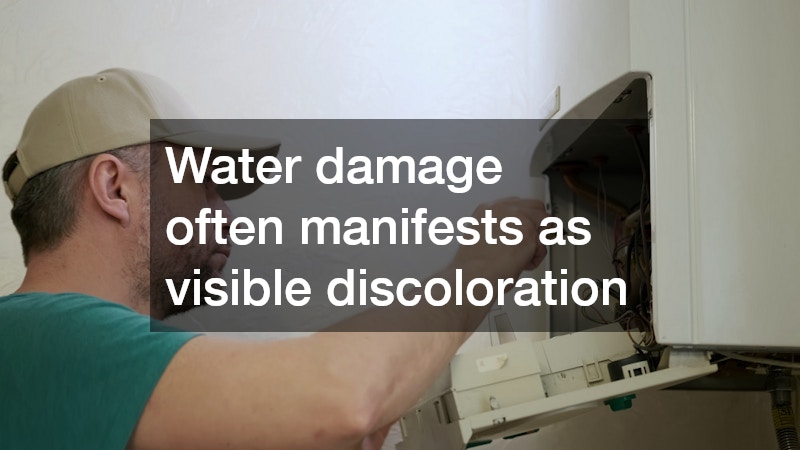Water damage can develop quietly in a home, often unnoticed until significant problems arise. From small leaks behind walls to hidden moisture under floors, the effects of water intrusion can compromise both the structure of your home and your health. Early detection prevents costly repairs and maintains a safe living environment. Professional water damage services can help homeowners identify and address issues before they escalate. Understanding the subtle signs of water damage allows you to take proactive measures to protect your home from long-term consequences and ensure a healthier, more comfortable space.
Identifying Discoloration on Walls and Ceilings
Water damage often manifests as visible discoloration on walls and ceilings. Stains may appear yellow, brown, or even darker, indicating moisture seeped into the building materials. These patches may initially seem minor, but they can signify a more serious problem behind the surface. Recognizing these early signs is crucial, as they are often the first indication of leaks or condensation issues needing attention.
In more specific terms, these stains are frequently found near plumbing fixtures, rooflines, or areas prone to condensation. For example, a ceiling spot under a bathroom might point to a leaky shower drain, while a yellowed patch near an exterior wall could indicate a compromised roof or siding. Tracking the size and shape of discoloration over time can provide insight into the severity of the water intrusion and guide decisions about repairs.
Recognizing Unusual Odors in Living Spaces
Persistent, musty odors in a home are another key indicator of hidden water damage. Moist environments encourage the growth of mold and mildew, which produce distinctive smells that are difficult to ignore. Even if no visible signs of moisture are present, these odors can suggest that water has infiltrated areas such as behind walls, under carpets, or in crawl spaces. Identifying these smells early can prevent further damage and reduce the risk of health problems associated with mold exposure.
Homeowners should pay attention to areas that are typically damp or poorly ventilated, such as basements, laundry rooms, and bathrooms. A musty smell in these locations often signals that water has been present for an extended period, allowing mold spores to proliferate. Using a moisture meter or hiring a professional to inspect these areas can confirm the source and extent of the damage, guiding practical remediation efforts.
Detecting Warping or Buckling in Floors
Changes in the texture or alignment of flooring are common signs of water intrusion. Wood, laminate, and even vinyl floors can warp, buckle, or separate when exposed to prolonged moisture. These distortions not only affect a home’s aesthetics but can also indicate that structural damage is occurring beneath the surface. Early detection of floor irregularities helps prevent more extensive repairs and ensures the safety of residents.
Specifically, homeowners should inspect areas near sinks, toilets, and exterior doors, where water is more likely to seep in. Small gaps between floorboards, uneven surfaces, or a spongy feeling underfoot are all warning signs that water has infiltrated the subfloor. Addressing these issues quickly through repair or replacement, in combination with water damage services if necessary, can prevent long-term structural problems and maintain the integrity of your flooring.
Observing Mold or Mildew Growth Indoors
The appearance of mold or mildew signals that water has compromised a section of your home. Mold often grows in areas with consistent moisture, such as behind walls, under sinks, or around windows. Its presence can cause structural damage and health concerns, including allergies and respiratory issues. Regularly checking for mold is essential to maintaining a safe and healthy home environment.
In more specific terms, mold may appear as black, green, or white patches on surfaces, often accompanied by a damp smell. It thrives in hidden spots, making it critical to inspect less obvious areas such as behind furniture, inside cabinets, or in attic spaces. Professional water damage services can help detect mold early, safely remove it, and treat the affected areas to prevent recurrence.
Listening for Dripping or Running Water Sounds
Unusual dripping or running water sounds can indicate hidden leaks within walls, ceilings, or plumbing systems. Even if no water is visible, these sounds often indicate a leak that could lead to significant damage if left unaddressed. Homeowners should pay attention to faint or continuous water noises, as timely intervention can reduce repair costs and prevent further deterioration of home structures.
Specifically, leaks behind walls may produce rhythmic dripping sounds, while pipes under sinks or in basements may generate continuous running noises. Nighttime is often the best time to listen for these signs, as ambient household noise is minimal. Using acoustic leak detectors or contacting water damage services can help locate and repair these hidden sources efficiently, mitigating potential damage.
Spotting water damage early is crucial for protecting your home, health, and investment. By observing discoloration on walls, detecting unusual odors, monitoring flooring for warping, checking for mold growth, and listening for hidden leaks, homeowners can take proactive steps to address moisture issues. Combining these observational techniques with professional water damage services ensures thorough detection and effective remediation. Staying vigilant and acting quickly not only preserves the integrity of your home but also fosters a safer and more comfortable living environment for everyone.





